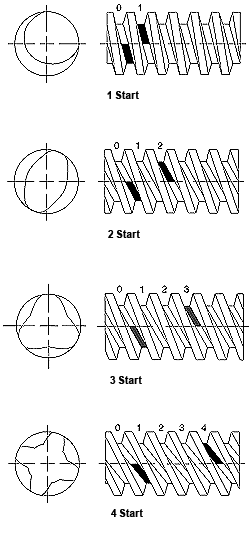Identifying Hand of the Thread
The hand of the thread can be easily determined by visual inspection. Simply compare your screw threads with the right hand and left-hand threads illustrated in Figure 48.
- Most threads are right hand and right hand is assumed if no left-hand designation is specified.
- Left-hand threads are common on manual drives where clockwise handle rotation raises, tightens, extends, or creates motion away from the operator.
- On fine threads, it may be necessary to lay a small wire in the thread grooves to determine the hand. Matching the angle of the lie of the wire with the illustrations will indicate the hand of thread.

FIGURE 48
Different Number of Starts
The number of starts on most threads is one (single start).
However, a number of thread series including Roton’s Hi – lead®, Torqspline® Lead Screw, and Ball Screw series screw threads may have from 2 to 20 starts or more.
Multiple starts are used to increase the lead (linear advancement per revolution).
In most cases, increasing the number of starts is preferable to increasing the pitch because larger pitches reduce the minor diameter. A small minor diameter decreases the screw stiffness and makes it more difficult to tap nuts because of the likelihood of the tap breaking during tapping. Also, for the same lead, increasing the number of starts actually increases the thread contact area when compared to a thread with the same lead but using fewer starts and a coarser pitch.
Close examination of the thread will reveal the number of starts (Figure 49). Simply place a pencil or marker pen in the thread groove and rotate the thread one revolution.
- If the end of the pencil mark is in the adjacent thread groove, the screw has a single start.
- If there is one thread between the beginning and the end of the mark, it is a two-start thread, two grooves, a three-start thread and so on.
- Another way to discover the thread starts is to examine a transverse section of the screw. As illustrated in Figure 49, if the end view is an offset circle, the screw is a single start. A two-start thread will have roughly a football shape, a three-start thread will have a tri-oval shape and a four-start thread will be noticeably four-cornered.
- Usually, five starts and up can simply be counted in the transverse section.

FIGURE 49